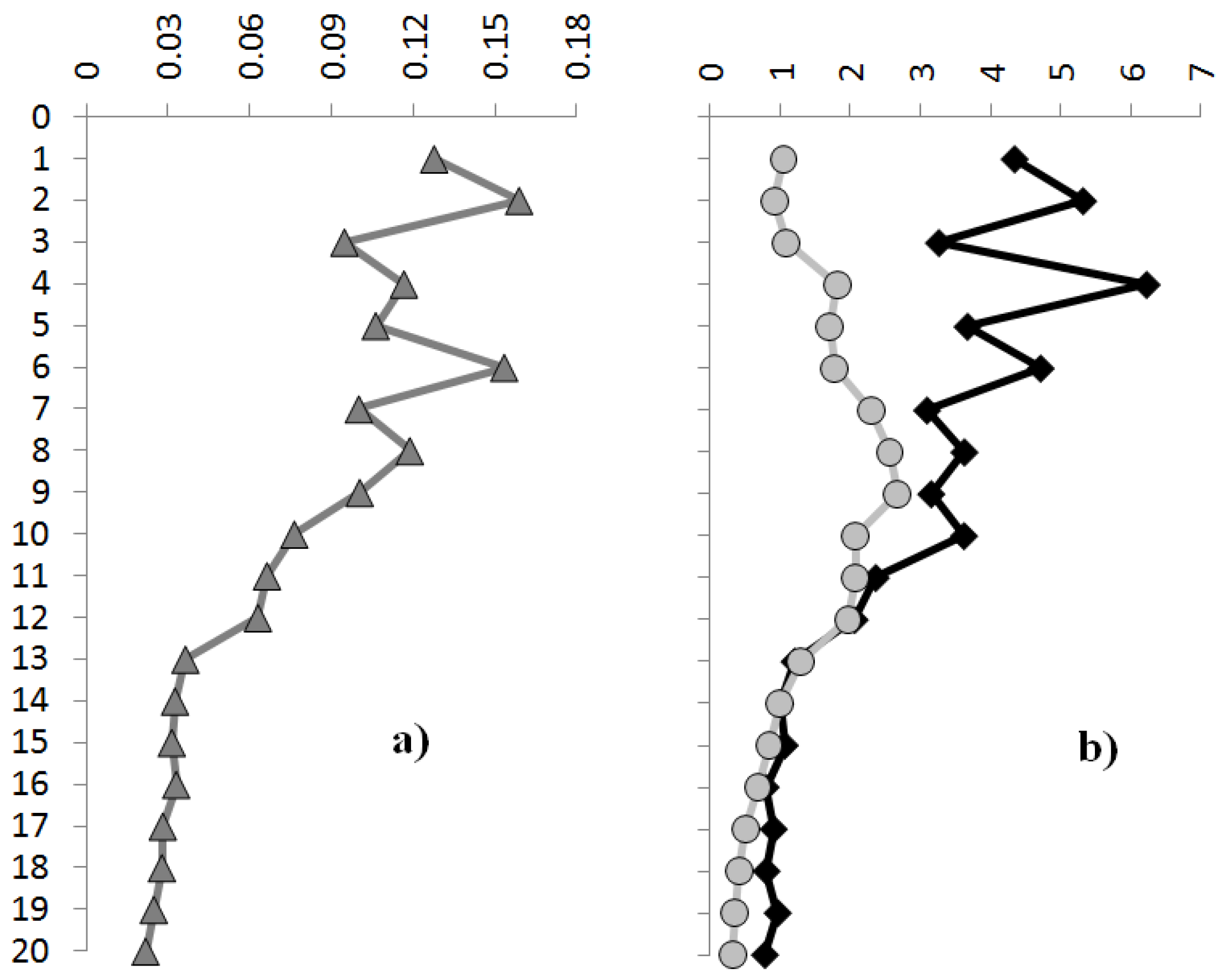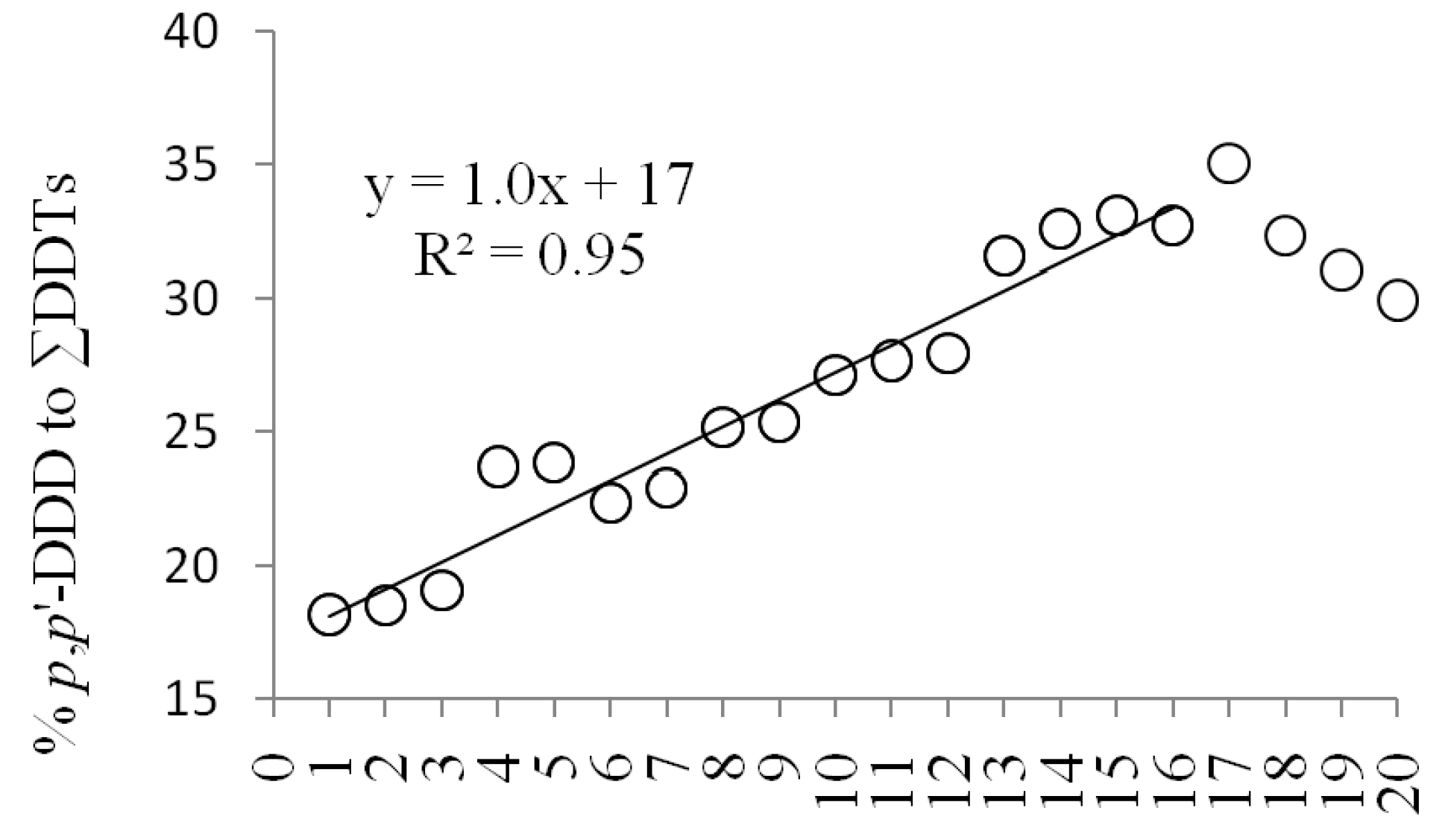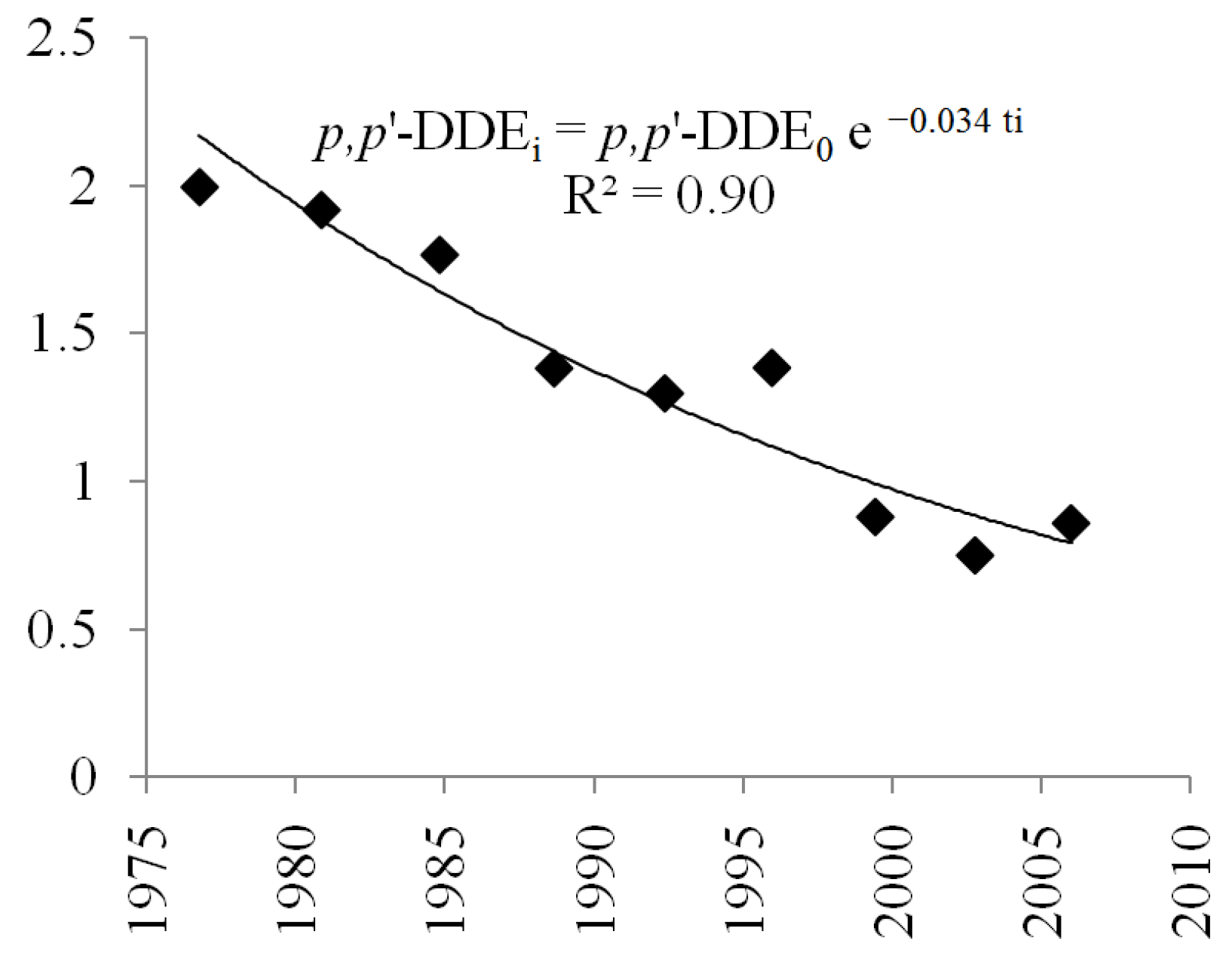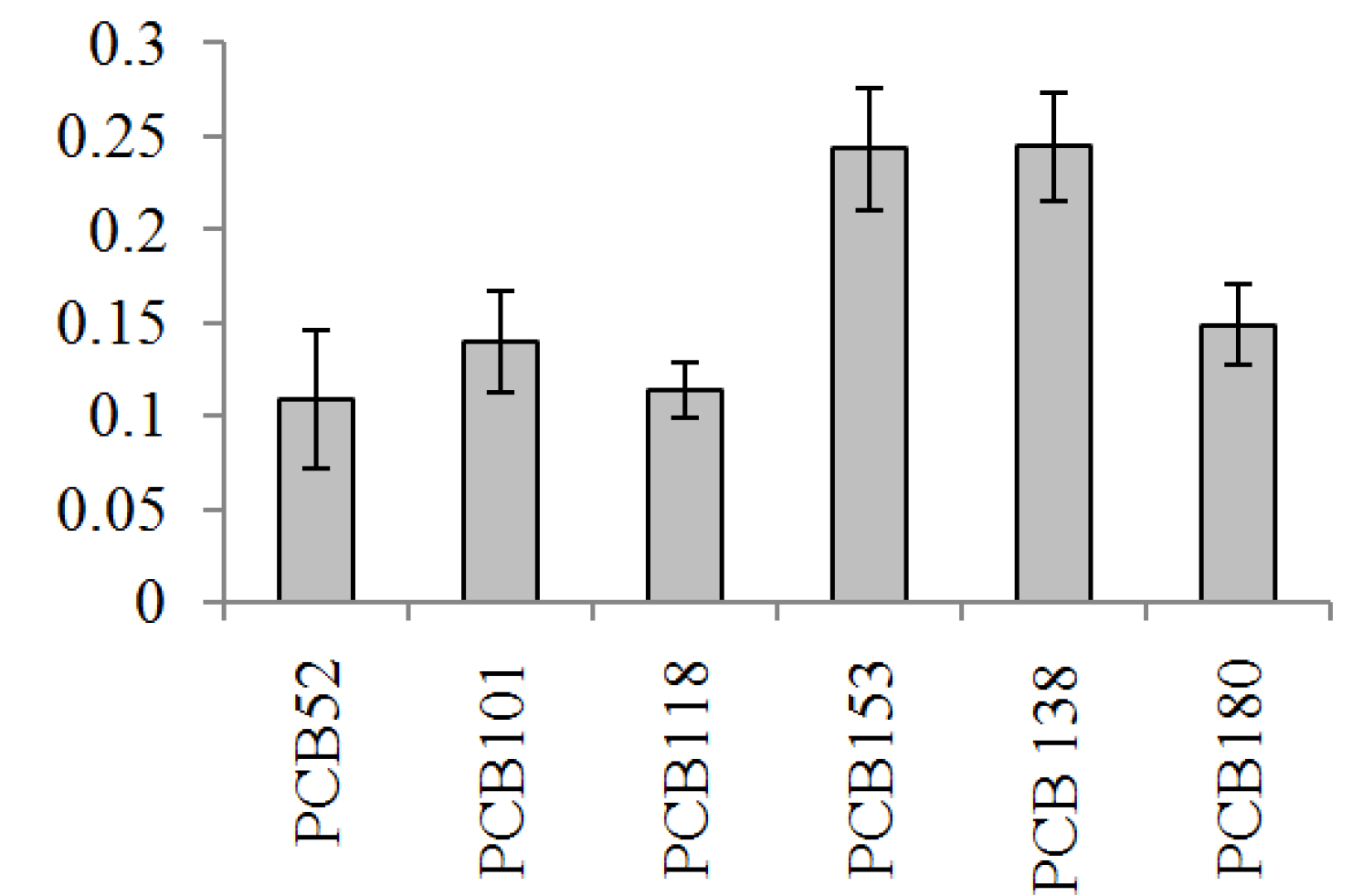Sensitivity of a Remote Alpine System to the Stockholm and LRTAP Regulations in POP Emissions
Abstract
:1. Introduction
2. Experimental Section
2.1. Materials and Methods
2.2. Sampling at Gossenköllesee
2.3. POPs Analyses
2.4. Total Organic Carbon (TOC) Analysis
2.5. Quality Control
3. Results and Discussion

| # | Est.dating | Age Error (± yrs) | TOC % | HCB | ∑PCB | ∑DDT |
|---|---|---|---|---|---|---|
| 1 | 2006 | 15 | 8.78 | 0.13 | 4.3 | 1.0 |
| 2 | 2003 | 15 | 8.33 | 0.16 | 5.3 | 0.92 |
| 3 | 1999 | 9 | 8.52 | 0.09 | 3.3 | 1.1 |
| 4 | 1996 | 10 | 7.96 | 0.12 | 6.2 | 1.8 |
| 5 | 1992 | 8 | 8.90 | 0.11 | 3.7 | 1.7 |
| 6 | 1989 | 7 | 7.92 | 0.15 | 4.7 | 1.8 |
| 7 | 1985 | 9 | 7.93 | 0.10 | 3.1 | 2.3 |
| 8 | 1981 | 10 | 7.99 | 0.12 | 3.6 | 2.6 |
| 9 | 1977 | 13 | 8.02 | 0.10 | 3.1 | 2.7 |
| 10 | 1973 | 15 | 8.11 | 0.08 | 3.6 | 2.1 |
| 11 | 1968 | 16 | 8.25 | 0.07 | 2.3 | 2.1 |
| 12 | 1964 | 17 | 7.97 | 0.06 | 2.1 | 2.0 |
| 13 | 1959 | 19 | 7.98 | 0.04 | 1.2 | 1.3 |
| 14 | 1950 | 24 | 7.31 | 0.03 | 1.0 | 0.99 |
| 15 | 1940 | 24 | 7.26 | 0.03 | 1.1 | 0.84 |
| 16 | 1929 | 19 | 7.34 | 0.03 | 0.79 | 0.68 |
| 17 | 1918 | 13 | 7.51 | 0.03 | 0.91 | 0.50 |
| 18 | 1907 | 14 | 7.31 | 0.03 | 0.80 | 0.41 |
| 19 | 1895 | 21 | 7.36 | 0.02 | 0.96 | 0.36 |
| 20 | 1882 | 21 | 7.62 | 0.02 | 0.78 | 0.32 |
3.1. DDTs



3.2. HCB and PCBs
| p,p'-DDE | p,p'-DDD | HCB | PCB #52 | PCB #101 | PCB #118 | BCB #138 | PCB #153 | PCB #180 | ∑PCB | |
|---|---|---|---|---|---|---|---|---|---|---|
| p,p'-DDE | 0.92 | |||||||||
| p,p'-DDD | 0.92 | |||||||||
| HCB | −0.09 | −0.41 | ||||||||
| PCB#52 | −0.31 | −0.46 | 0.62 | |||||||
| PCB#101 | −0.26 | −0.43 | 0.71 | 0.98 | ||||||
| PCB#118 | −0.13 | −0.36 | 0.83 | 0.88 | 0.94 | |||||
| BCB#138 | −0.07 | −0.37 | 0.90 | 0.67 | 0.77 | 0.88 | ||||
| PCB#153 | 0.04 | −0.29 | 0.93 | 0.67 | 0.75 | 0.87 | 0.95 | |||
| PCB#180 | 0.15 | −0.14 | 0.77 | 0.77 | 0.81 | 0.85 | 0.87 | 0.91 | ||
| ∑PCB | −0.12 | −0.38 | 0.86 | 0.89 | 0.94 | 0.97 | 0.92 | 0.92 | 0.93 | |
| ∑DDT | 0.99 | 0.96 | −0.19 | −0.35 | −0.31 | −0.20 | −0.16 | −0.05 | 0.07 | −0.20 |

4. Conclusions
Acknowledgments
Author Contributions
Conflicts of Interest
References and Notes
- Breivik, K.; Sweetman, A.; Pacyna, J.M.; Jones, K.C. Towards a global historical emission inventory for selected PCB congeners-a mass balance approach. 1. Global production and comsumption. Sci. Total Environ. 2002, 290, 181–198. [Google Scholar]
- Breivik, K.; Sweetman, A.; Pacyna, J.M.; Jones, K.C. Towards a global historical emission inventory for selected PCB congeners-a mass balance approach. 2. Emissions. Sci. Total Environ. 2002, 290, 199–224. [Google Scholar] [CrossRef]
- Pacyna, J.M.; Breivik, K.; Münch, J.; Fudala, J. European atmospheric emissions of selected persistent organic pollutants, 1970–1995. Atmos. Environ. 2003, 37, S119–S131. [Google Scholar]
- Calamari, D.; Bacci, E.; Focardi, S.; Gaggi, C.; Morosini, M.; Vighi, M. Role of plant biomass in the global environment partitioning of chlorinated hydrocarbons. Environ. Sci. Technol. 1991, 25, 1489–1495. [Google Scholar] [CrossRef]
- Lohmann, R.; Breivik, K.; Dachs, J.; Muir, D. Global fate of POPs: Current and future research directions. Environ. Pollut. 2007, 150, 150–165. [Google Scholar] [CrossRef]
- Meijer, S.N.; Ockenden, W.A.; Sweetman, A.; Breivik, K.; Grimalt, J.O.; Jones, K.C. Global distribution and budget of PCBs and HCB in background surface soils: Implications for sources and environmental processes. Environ. Sci. Technol. 2003, 37, 667–672. [Google Scholar] [CrossRef]
- Carrera, G.; Fernandez, P.; Grimalt, J.O.; Ventura, M.; Camarero, L.; Catalan, J.; Nickus, U.; Thies, H.; Psenner, R. Atmospheric deposition of organochlorine compounds to remote high mountain lakes of Europe. Environ. Sci. Technol. 2002, 36, 2581–2588. [Google Scholar] [CrossRef]
- Galbán-Malagón, C.J.; Del Vento, S.; Cabrerizo, A.; Dachs, J. Factors affecting the atmospheric occurence and deposition of polychlorinated biphenyls in the Southern Ocean. Atmos. Chem. Phys. 2013, 13, 12029–12041. [Google Scholar] [CrossRef]
- Hung, H.; Kallenborn, R.; Breivik, K.; Su, Y.; Brorström-Lundén, E.; Olafsdottir, K.; Thorlacius, J.M.; Leppänen, S.; Bossi, R.; Skov, H.; et al. Atmospheric monitoring of organic pollutants in the Arctic under the Arctic Monitoring and Assessment Programme (AMAP): 1993–2006. Sci. Total Environ. 2010, 408, 2854–2873. [Google Scholar] [CrossRef]
- van Drooge, B.L.; Grimalt, J.O.; Camarero, Ll.; Catalan, J.; Stuchlík, E.; Torres-García, C.J. Atmospheric semi-volatile organochlorine compounds in European high mountain areas (Central Pyrenees and High Tatras). Environ. Sci. Technol. 2004, 38, 3525–3532. [Google Scholar] [CrossRef]
- Blais, J.M.; Schindler, D.W.; Muir, D.C.G.; Kimpe, L.E.; Donald, D.B.; Rosenberg, B. Accumulation of persistent organochlorine compounds in mountains of western Canada. Nature 1998, 395, 585–588. [Google Scholar] [CrossRef]
- Grimalt, J.O.; Fernández, P.; Berdie, L.; Vilanova, R.M.; Catalan, J.; Psenner, R.; Hofer, R.; Appleby, P.G.; Rosseland, B.O.; Lien, L.; et al. Selective trapping of organochlorine compounds in mountain lakes of temperate areas. Environ. Sci. Technol. 2001, 35, 2690–2697. [Google Scholar] [CrossRef]
- Wania, F.; Mackay, D. Tracking the distribution of persistent organic pollutants. Environ. Sci. Technol. 1996, 30, 390–397. [Google Scholar] [CrossRef]
- Vives, I.; Grimalt, J.O.; Catalan, J.; Rosseland, B.O.; Battarbee, R.W. Influence of altitude and age in the accumulation of organochlorine compounds in fish from high mountain lakes. Environ. Sci. Technol. 2004, 38, 690–698. [Google Scholar] [CrossRef]
- Denier van der Gon, H.; van het Bolscher, M.; Visschedijk, A.; Zandveld, P. Emissions of persistent organic pollutants and eight candidate POPs from UNECE-Europe in 2000, 2010 and 2020 and the emission reduction resulting from the implementation of the UNECE POP protocol. Atmos. Environ. 2007, 41, 9245–9261. [Google Scholar] [CrossRef]
- EEA. European Union Emission Inventory Report 1990–2009 under the UNECE Convention on Long-Range Transboundary Air Pollution (LRTAP); Technical Report No 9/2011; European Environmental Agency: Copenhagen, Denmark, 2011. [Google Scholar]
- Becker, S.; Halsall, C.J.; Tych, W.; Kallenborn, R.; Schlabach, M.; Manø, S. Changing sources and environmental factors reduce the rates of decline of organochlorine pesticides in the Arctic atmosphere. Atmos. Chem. Phys. 2012, 12, 4033–4044. [Google Scholar] [CrossRef]
- Halse, A.K.; Schlabach, M.; Eckhardt, S.; Sweetman, A.; Jones, K.C.; Breivik, K. Spatial variability of POPs in European background air. Atmos. Chem. Phys. 2011, 11, 1549–1564. [Google Scholar]
- Schuster, J.K.; Goia, R.; Breivik, K.; Steinness, E.; Scheringer, M.; Jones, K.C. Trends in European background air reflects reductions in primary emissions of PCBs and PBDEs. Environ. Sci. Technol. 2010, 44, 6760–6766. [Google Scholar] [CrossRef]
- Fernández, P.; Grimalt, J.O. On the global distribution of persistent organic pollutants. Chimia 2003, 57, 514–521. [Google Scholar] [CrossRef]
- Dachs, J.; Eisenreich, S.J.; Baker, J.E.; Ko, F.C.; Jeremiason, J.D. Coupling of phytoplankton uptake and air-water exchange of persistent organic pollutants. Environ. Sci. Technol. 1999, 33, 3653–3660. [Google Scholar] [CrossRef]
- Meijer, S.N.; Dachs, J.; Fernández, P.; Camarero, L.; Catalan, J.; Del Vento, S.; Van Drooge, B.; Jurado, E.; Grimalt, J.O. Modelling the dynamic air-water-sediment coupled fluxes and occurence of polychlorinated biphenyls in a high altitude lake. Environ. Pollut. 2006, 140, 546–560. [Google Scholar] [CrossRef]
- Grimalt, J.O.; van Drooge, B.L.; Ribes, A.; Vilanova, R.M.; Fernandez, P.; Appleby, P.G. Persistent organochlorine compounds in soils and sediments of European high altitude mountain lakes. Chemosphere 2004, 54, 1549–1561. [Google Scholar] [CrossRef]
- Koinig, K.A.; Kamenik, C.; Schmidt, R.; Agustí-Panareda, A.; Appleby, P.; Lami, A.; Prazakova, M.; Rose, N.; Schnell, O.A.; Tessadri, R.; et al. Environmental changes in an alpine lake (Gossenköllesee, Austria) over the last two centuries—the influence of air temperature on biological parameters. J. Paleolimnol. 2002, 28, 147–160. [Google Scholar] [CrossRef]
- Schmid, P.; Bogdal, C.; Blüthingen, N.; Anselmetti, F.S.; Zwyssig, A.; Hungerbühler, K. The missing piece: Sediment records in remote mountain lakes confirm glaciers being secondary sources of persistent organic pollutants. Environ. Sci. Technol. 2011, 45, 203–208. [Google Scholar] [CrossRef]
- Nizzetto, L.; Macleod, M.; Borgå, K.; Cabrerizo, A.; Dachs, J.; Di Guardo, A.; Ghirardello, D.; Hansen, K.M.; Lindroth, A.; Ludwig, B.; et al. Past, present, and future controls on levels of persistent organic pollutants in the global environment. Environ. Sci. Technol. 2010, 44, 6526–6531. [Google Scholar] [CrossRef]
- Nizzetto, L.; Gioa, R.; Li, J.; Borgå, K.; Pomati, F.; Bettinetti, R.; Dachs, J.; Jones, K.C. Biological pump control of the fate and distribution of hydrophobic organic pollutants in water and plankton. Environ. Sci. Technol. 2012, 46, 3204–3211. [Google Scholar]
- Breivik, K.; Vestreng, V.; Rozovskaya, O.; Payna, J.M. Atmospheric emissions of some POPs in Europe: A discussion of existing inventories and data records. Environ. Sci. Policy 2006, 41, 9245–9261. [Google Scholar]
- Castro-Jiménez, J.; Dueri, S.; Eisenreich, S.J.; Mariani, G.; Skejo, H.; Umlauf, G.; Zaldívar, J.M. Polychlorinated biphenyls (PCBs) in the atmosphere of sub-alpine northern Italy. Environ. Pollut. 2009, 157, 1024–1032. [Google Scholar] [CrossRef]
© 2014 by the authors; licensee MDPI, Basel, Switzerland. This article is an open access article distributed under the terms and conditions of the Creative Commons Attribution license (http://creativecommons.org/licenses/by/3.0/).
Share and Cite
Van Drooge, B.L.; Garriga, G.; Koinig, K.; Psenner, R.; Pechan, P.; Grimalt, J.O. Sensitivity of a Remote Alpine System to the Stockholm and LRTAP Regulations in POP Emissions. Atmosphere 2014, 5, 198-210. https://doi.org/10.3390/atmos5020198
Van Drooge BL, Garriga G, Koinig K, Psenner R, Pechan P, Grimalt JO. Sensitivity of a Remote Alpine System to the Stockholm and LRTAP Regulations in POP Emissions. Atmosphere. 2014; 5(2):198-210. https://doi.org/10.3390/atmos5020198
Chicago/Turabian StyleVan Drooge, Barend L., Guillem Garriga, Karin Koinig, Roland Psenner, Paul Pechan, and Joan O. Grimalt. 2014. "Sensitivity of a Remote Alpine System to the Stockholm and LRTAP Regulations in POP Emissions" Atmosphere 5, no. 2: 198-210. https://doi.org/10.3390/atmos5020198
APA StyleVan Drooge, B. L., Garriga, G., Koinig, K., Psenner, R., Pechan, P., & Grimalt, J. O. (2014). Sensitivity of a Remote Alpine System to the Stockholm and LRTAP Regulations in POP Emissions. Atmosphere, 5(2), 198-210. https://doi.org/10.3390/atmos5020198






